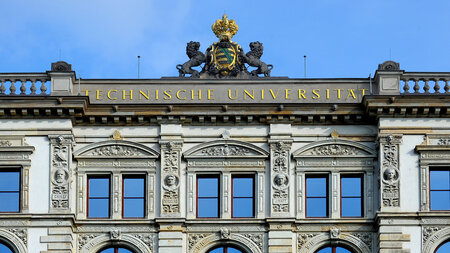Quasi-Particles in Nature: Two Worlds Finally Meet
Researchers from Leipzig University, Chemnitz University of Technology, and the University of Augsburg report in Chemical Science, the flagship journal of the Royal Society of Chemistry, about a phenomenon of solid-state physics they discovered in a biological system
-

Prof. Georgeta Salvan, member of the Professorship of Semiconductor Physics (Chemnitz University of Technology), and Prof. Jörg Matysik, Institute for Analytical Chemistry (Leipzig University), were involved in the study. Photo/graphic: Jacob Müller
In solid state-physics, energetic excitations, such as light absorption in molecular crystals, lead to distortions of spatial structure or a shift of electrical charge. These excited states are often described as so-called quasi-particles. A polaron, for instance, is a positive charge along with its surrounding environment, where negative charges have formed. But how does this happen in biological photoreceptors?
The function of photoreceptors is investigated in photobiology. They always contain a pigment that absorbs light. How does the light-sensitive receptor molecule rhodopsin in the eye work? Why can bacteria move towards a light source? How do migratory birds know their desired flight direction so precisely? Photobiology answers these questions with concepts of theoretical organic chemistry. Rhodopsin contains vitamin A (retinal) as a pigment, in which a C=C double bond is photochemically rotated. Flavin proteins, it is suspected, allow the eyes of migratory birds to start chemical processes under illumination that are magnetic field-dependent and are referred to as the radical pair mechanism.
And what about plants? Their "eye" is a photoreceptor named phytochrome. It tells plants and cyanobacteria how bright it is and whether photosynthesis is worthwhile. This photoreceptor protein contains an open-chain tetrapyrrole cofactor as a pigment that absorbs the light. For phytochrome too, it was first recognized that light turns a C=C double bond, triggering a cascade of small movements in the surroundings. These are all terms from organic chemistry that have been incorporated into structural biology.
A new study, the results of which have now been published in the journal Chemical Science, examined this light-triggered switching process in a cyanobacterial phytochrome. With the help of a special new sample preparation method introduced by doctoral student Lisa Köhler (Leipzig University), the intermediate steps of the reaction course could also be observed. In the working group of Prof. Dr. Jörg Matysik (Institute for Analytical Chemistry at Leipzig University), detailed data could be collected from all reaction steps in this way using nuclear magnetic resonance (NMR). "In fact, the data show a C=C double bond isomerization. This leads to a disturbance of the double bond system, a positively charged defect, which should actually be able to move along the double bond system," says Matysik. Because of its charge, however, it attracts negative charge and is thus fixed at a certain point. So here lies a polaron, as known from solid state physics, and it is self-trapped (localized).
Prof. Dr. Georgeta Salvan, member of the Professorship of Semiconductor Physics at Chemnitz University of Technology, who was involved in interpreting the data, explains: "The molecular structure of the open-chain tetrapyrrole resembles some molecules, like α-sexithiophen, which are used as organic semiconductors. Therefore, one could already suspect that similar phenomena can be observed in this photoreceptor. We are faced with the question of whether phenomena of solid-state physics do not occur more frequently in biological systems, but are not found because we do not look for them."
Publication: Lisa Köhler, Wolfgang Gärtner, Georgeta Salvan, Jörg Matysik, Christian Wiebeler, Chen Song; "Photocycle of a cyanobacteriochrome: Charge defect on ring C impairs conjugation in chromophore"; Chemical Science, online (2023).
DOI: 10.1039/D3SC00636K (https://pubs.rsc.org/en/content/articlepdf/2023/SC/D3SC00636K?page=search)
Further information is provided by Prof. Dr. Georgeta Salvan, Professorship of Semiconductor Physics (Chemnitz University of Technology), tel. +49 (0)371 531-33137, e-mail salvan@physik.tu-chemnitz.de, and Prof. Dr. Jörg Matysik, Institute for Analytical Chemistry (Leipzig University), tel. +49 (0)341 9736112, e-mail joerg.matysik@uni-leipzig.de
(Article: Mario Steinebach / Translation: Brent Benofsky)
Matthias Fejes
19.05.2023





